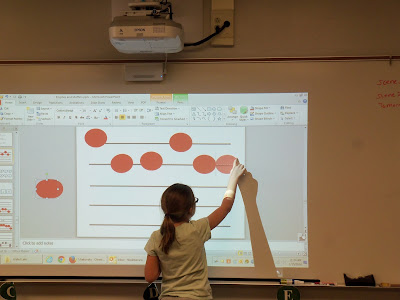Kindergarten students focused heavily on steady beat this week. First, students learned a new song called Circle 'Round the Zero which allowed students to take turns being the leader and practice walking a steady beat. Then students learned a patting and clapping pattern to Chinese Dance from the Nutcracker. During this activity, students were assessed on their ability to keep a steady beat. Students will be graded on their ability to keep a steady beat on their report card later this month. Progress on this standard will also be reported at the end of the second semester in to show student development in this skill area. It is common for Kindergarten students, at this point in the school year, to still be developing their ability to keep a steady beat.
First grade students enjoyed learning a new song called What Shall We Do When We All Go Out? During this song, students walked around the room to the steady beat while looking for friends with which to act out a chosen outdoor activity. After singing the song, students then worked with their friends to act out activities such as making snow angels, sledding, and building a snow fort while the teacher accompanied the students on the piano. Students also reviewed the lines and spaces of the staff and learned to write short sol and mi melodic patterns on the music staff. Additionally, students explored the upper range of their voices in a fun activity which involved shooting an imaginary basketball into an imaginary hoop. Students made the sliding sound (descending glissando) of the ball going through the hoop and down to the ground. Students also reviewed the sol and mi song Snail, Snail through a parachute game.
 |
| This student has correctly written the pattern sol-mi-sol-sol-mi. |
 | |
| These children have also correctly written this pattern, yet on a different set of lines. |
 |
| This student is writing a sol-mi pattern on the interactive white board. |
Third grade students learned a new do-re-mi-sol-la song entitled Ida Red. Students enjoyed learning the game for this song which involves two students racing around the outside of a circle and exchanging envelopes. Students also worked on developing the upper range of their singing voice through a vocal exploration exercise. In this exercise, students were asked to mimic the contour (the ups and downs) of roller coasters and water slides with their voices. Students also continued to practice singing melodic patterns containing melodic notes do re mi sol and la from flashcards. Lastly, students completed a rhythm reading assessment by reading rhythm flashcards while a funky blues background track was played.
Fourth grade students learned the purple belt song, Old MacDonald Had a Farm, this week. This song uses the notes B-A-G-E-D. The most difficult thing about this song for many students is creating a good sound while playing E and D. The trick to playing these notes with a good sound is to be sure that all finger holes are covered securely and to blow gently and with warm air - as if fogging up a window. Next week, students will be introduced to new concepts, such as ties, that are in the blue belt song Oh, When the Saints.
Fifth grade students added 'conserve your air' to their list of vocal techniques this week. Students practiced stretching their air over a long phrase through an exercise entitled One Man and His Dog. Students were challenged to make it through the continuously lengthened second phrase without taking a breath. Students were also introduced to solfege (do re mi fa sol la ti do'), a series of solmization syllables invented over one thousand years ago. Students sang a C major scale using these syllables, learned the hand signs for them, and transferred them to a written C major scale. Additionally, students listened to the beginning of Dr. Martin Luther King, Jr.'s speech We Shall Overcome, discussed the significance of this speech, and listened to Pete Seeger's recording of a song by the same name, We Shall Overcome. Students were then led to make connections between Martin Luther King, Jr.'s speech and the song. Additionally, students sung the canon Oh, What a Wondrous Thing in two and three parts.
No comments:
Post a Comment